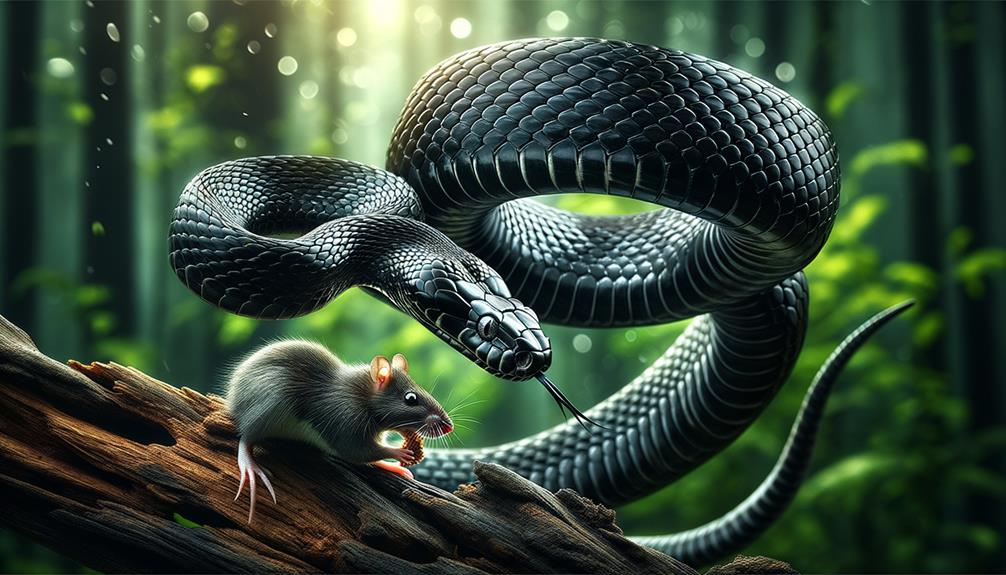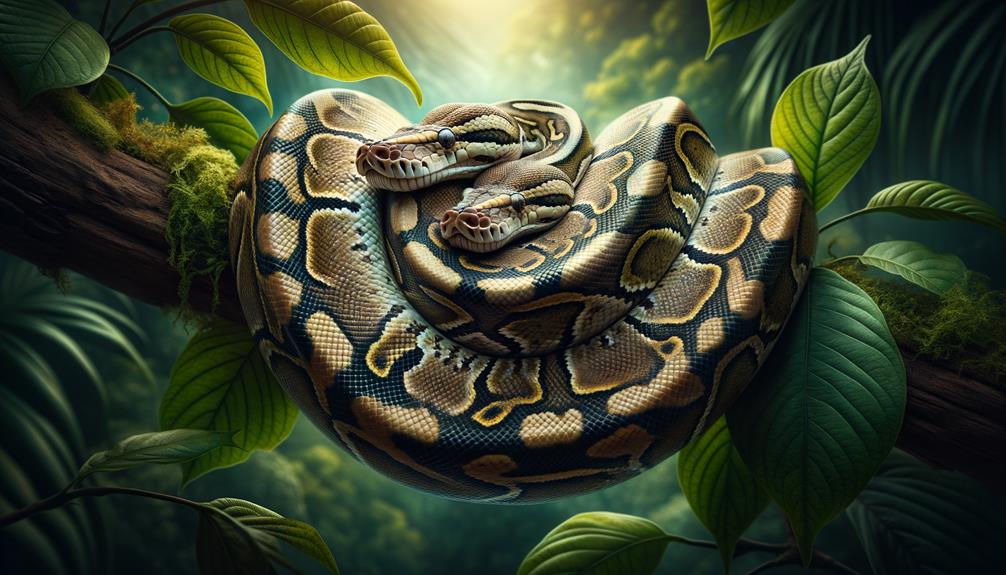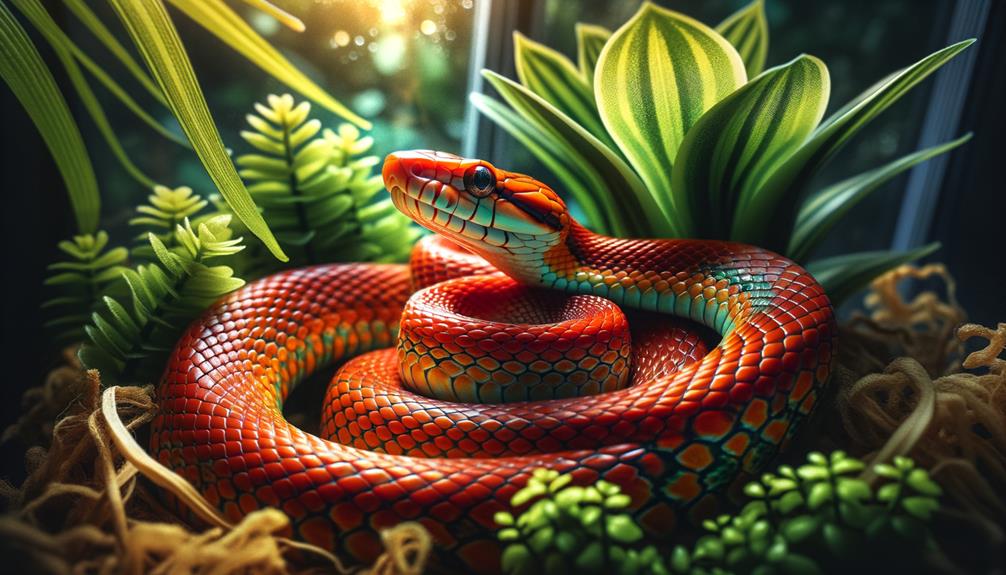Rat snakes, also known as Pantherophis alleghaniensis, play a vital role in maintaining ecological balance across North American habitats. These adaptable serpents can grow up to 10 feet long, allowing them to ambush and constrict their prey with ease. With their keen senses and agility, aided by keeled scales, they’re exceptional climbers and hunters. They inhabit varied environments, from forests to abandoned buildings, feeding on rodents and birds. With a lifespan of up to 15 years, their role in controlling pest populations is crucial. To learn more about their fascinating behaviors and life cycles, there’s still much to uncover.
Key Takeaways
Rat snakes are expert hunters that rely on their sharp senses and cunning ambush techniques to catch rodents. By controlling rodent populations, they maintain a delicate ecological balance. Their unique, keeled scales and slender bodies allow them to climb and maneuver with ease, making them well-suited for the hunt. Once they’ve caught their prey, rat snakes use constriction to immobilize and then consume their rodent quarry. These snakes thrive in environments that provide shelter, such as old boards, tin sheets, and rock crevices, where they can hunt and hide with ease.
What Are Rat Snakes?
Rat snakes, found across various North American habitats, are non-venomous reptiles scientifically known as Pantherophis alleghaniensis. Snakes are often misunderstood creatures, viewed with undue fear and suspicion. However, rat snakes play a crucial role in maintaining ecological balance. These adaptable serpents thrive in diverse environments, from dense forests to open fields and even urban areas, demonstrating their remarkable resilience and versatility.
As I delve into the world of rat snakes, I find it fascinating how they contribute to controlling rodent populations, thereby indirectly supporting human agricultural endeavors. Their presence indicates a healthy ecosystem, as they are integral predators within their food webs. Rat snakes are often seen as beneficial because they help regulate the populations of various prey species, including rodents and birds, which can become pests if left unchecked.
Moreover, rat snakes exhibit intriguing behaviors that underscore their adaptability. They are proficient climbers and swimmers, allowing them to access a wide range of prey. By constricting their prey, they efficiently secure their meals, showcasing their evolved hunting strategies. Understanding these aspects of rat snakes enriches our appreciation for their role in nature and underscores the importance of conserving their habitats.
Physical Characteristics

When examining rat snakes, I find their physical characteristics to be remarkably diverse and adapted for their role as efficient hunters. Their slender bodies and keeled scales come in various colors and patterns, ranging from black and red to yellow and gray. Some species can grow up to an impressive 10 feet in length, which boosts their ability to control rodent populations.
Color and Pattern Variations
Exhibiting a wide range of colors and intricate patterns, rat snakes showcase their remarkable adaptability in their physical characteristics. For instance, black rat snakes display a deep, glossy black coloration that helps them blend in with forest shadows and dark underbrush, making them expert hunters. This camouflage enables them to sneak up on their prey undetected. The diversity in coloration goes beyond black, with some rat snakes sporting vibrant red, subtle brown, or muted gray tones, each hue providing a strategic advantage in different environments.
The patterns on their bodies, whether blotches or stripes, play a crucial role in their survival. These visual variations break up the outline of their slender bodies, making it challenging for both predators and prey to detect them. The keeled scales add texture and depth to their appearance, further aiding in their camouflage. Their wedge-shaped heads and round pupils also contribute to their keen hunting abilities, allowing them to navigate and ambush prey efficiently.
This remarkable flexibility in physical traits is a testament to the evolutionary success of rat snakes. These snakes have developed physical characteristics that not only ensure their survival but also highlight their adaptability and ingenuity in their natural habitats.
Size and Length Range
Building on their diverse colorations and patterns, rat snakes exhibit a notable range in size, with some individuals reaching impressive lengths of up to 10 feet. Typically, they range from 3.5 to 7 feet long, although exceptions exist. This considerable size variability has significant implications for their ecological role as rodent hunters.
Their slender bodies give them an agile advantage when pursuing prey. The physical dimensions of rat snakes allow them to efficiently navigate different environments, from dense forests to open fields, which enhances their ability to control rodent populations. Their slender build, combined with their keeled scales and wedge-shaped heads, facilitates their movement through tight spaces where rodents might hide.
The size of a rat snake directly influences its hunting capabilities. Larger individuals can tackle bigger rodents, playing a vital part in maintaining the balance within their ecosystems. Their specialized jaws, capable of swallowing prey larger than their heads, further accentuate their predatory efficiency. By understanding the size range of rat snakes, we can better appreciate their indispensable role in regulating rodent populations and sustaining ecological harmony.
Scales and Texture
Rat snakes’ unique scales, characterized by their rough texture, play a crucial role in enhancing their climbing abilities by providing essential grip on various surfaces. These scales create friction, allowing rat snakes to navigate effortlessly through dense vegetation and narrow spaces with ease. Contrary to popular belief, their scales aren’t slimy; instead, they provide both protection and flexibility, essential for agile movements in diverse environments.
The texture of rat snake scales varies in color and pattern, offering not just aesthetic appeal but practical benefits like camouflage and thermal regulation. The intricate arrangement of these scales also plays a vital role in the snake’s sensory abilities. By detecting subtle vibrations and minute changes in their surroundings, these scales enable rat snakes to respond swiftly to potential threats or prey.
Moreover, the scales contribute to the overall efficiency of the rat snake’s movements. By reducing friction, they promote smooth and fluid motion, whether slithering across forest floors or climbing trees. This blend of form and function, inherent in their scales, underscores the adaptability and survival prowess of rat snakes in their natural habitats.
Habitat and Distribution

Rat snakes thrive in diverse habitats across North America, from the dense forests of Southern Canada to the arid regions of Central America. In regions like North Carolina, these adaptable reptiles can be found in various environments, including old boards, tin sheets, brick piles, and dilapidated buildings. These structures provide ample opportunities for finding their primary food sources, such as toads, rodents, and chipmunks.
Rat snakes are drawn to habitats that offer both shelter and sustenance. By creating rock piles, log piles, and brush piles, and maintaining diverse plant cover, you can attract rat snakes by offering hiding spots and an abundance of prey. They often return to specific structures, such as vertical rock walls or rock crevices, for shedding their skins, emphasizing their preference for stable, long-term habitats.
Providing various types of shelters like wood stacks, rock crevices, burrows, and snake boxes can enhance the suitability of an area for rat snakes. Such environments not only offer protection but also secure the presence of rodent-type creatures, which rat snakes actively seek out as a primary food source.
Hunting Techniques

Rat snakes are skilled hunters that use their keen sense of smell and heat-sensing pits to ambush and capture rodents in their natural habitats. By remaining still for extended periods, they blend into their surroundings, making it unlikely for prey to detect them. This patient approach allows them to strike with precision when a rodent ventures too close.
Once a rodent is within reach, rat snakes use rapid, calculated movements to seize their prey. They constrict their prey, coiling around it and applying pressure until it suffocates. This technique ensures that the prey is immobilized, making it easier to swallow whole. Their ability to climb trees and navigate diverse terrains further enhances their efficiency as hunters.
Rat snakes play a crucial role in controlling rodent populations, which benefits both ecosystems and human environments. By keeping rodent numbers in check, they help maintain ecological balance and reduce the spread of diseases. Their sophisticated hunting techniques highlight the importance of rat snakes within their ecosystems, demonstrating their critical role in maintaining natural harmony.
Reproduction and Lifespan

When it comes to the reproduction and lifespan of rat snakes, it’s worth noting that their mating season usually takes place in the spring. During this time, they lay 12 to 20 eggs, which incubate for about two months before hatching. In the wild, rat snakes typically live for 10 to 15 years. Females reach sexual maturity at around 3 to 4 years, while males mature slightly faster, at 2 to 3 years.
Mating Season Timelines
Rat snakes begin their mating season in late spring, with the peak breeding period occurring from May to late June. This critical timeframe greatly influences their reproductive success and population dynamics. During these months, male rat snakes actively seek out females, often engaging in combat with rivals to secure mating rights.
Females lay clutches of 12 to 20 eggs in late July, carefully selecting nesting sites that provide the necessary conditions for successful incubation, which lasts about two months. The synchronization of these events with environmental cues in late spring and early summer ensures that hatchlings emerge during a time of optimal resource availability.
After hatching, the young snakes stay near the hatching site for up to two years, relying on the immediate environment for shelter and food. This initial period is crucial for their development and eventual dispersal, which contributes to the genetic diversity and resilience of the population. Understanding these timelines enables us to better protect and manage rat snake habitats, ensuring their continued survival and ecological role as rodent hunters.
Average Lifespan Details
Considering their ecological role and reproductive strategies, understanding the average lifespan of rat snakes provides valuable insights into their population dynamics and conservation needs. In the wild, rat snakes typically live for 10-15 years, demonstrating their adaptability and survival mechanisms. However, in controlled environments, some species can extend their lifespan up to an impressive 20-25 years, highlighting the significant impact of environmental factors on their longevity.
Female rat snakes reach sexual maturity relatively early, around 2-3 years of age. This early maturity enables them to contribute to the population quickly, laying clutches of 12-20 eggs. The reproductive capacity of these snakes ensures a steady influx of hatchlings, which are independent and capable of hunting from birth. This independence at a young age contributes to their survival rate, bolstering population numbers.
Analyzing the lifespan of rat snakes in both natural and controlled environments underscores the importance of preserving their habitats. By protecting their natural habitats from disturbance, we can support their ecological role as rodent controllers, which is critical for maintaining balanced ecosystems. This insight is crucial for developing effective conservation strategies.
Conservation Status

Conservation Status
Protecting rat snakes’ habitats is vital for maintaining ecosystem balance. Despite their stable population, ensuring their continued well-being is crucial. As skilled rodent hunters, rat snakes play a vital role in controlling rodent populations and maintaining ecosystem health.
Conservation efforts involve more than just population counts. It’s essential to safeguard their natural habitats and mitigate human-induced threats. Misconceptions and unwarranted fear often lead to unnecessary killings, so education and awareness campaigns are crucial. By promoting a better understanding of rat snakes’ ecological importance, we can reduce harm and promote coexistence.
Habitat protection is integral to their conservation. Urban development and habitat fragmentation pose significant risks. Preserving natural landscapes and creating green corridors can help sustain rat snake populations. Supporting these initiatives benefits not only rat snakes but also enhances biodiversity and ecosystem resilience. By participating in conservation efforts, we can ensure these remarkable creatures continue to thrive, highlighting their indispensable contribution to our natural world.
Frequently Asked Questions
What Are the Predators of the Rat Snake?
Rat snakes face threats from various predators, including birds of prey, mammals, larger snakes, and humans. To evade danger, they employ clever behavior and defensive tactics like musking.
Are Rat Snakes Aggressive to Humans?
Rat snakes are not aggressive towards humans. When threatened, they exhibit behaviors that mimic aggression, such as tail vibration and musk emission. These actions are defensive in nature, rather than a genuine threat. By respecting their space and handling them properly, you can minimize any perceived hostility.
Do Rat Snakes Eat Rodents?
Rat snakes play a crucial role in controlling rodent populations by consuming mice, rats, and chipmunks. Their unique jaws allow them to swallow prey whole, making them effective natural pest controllers.
Are Rat Snakes Good to Have Around?
I think rat snakes are a blessing in disguise. They provide a natural solution to our pest control problems. By preying on rodents and protecting crops, they help maintain a healthy ecosystem.
Do Rat Snakes Keep Copperheads Away?
Rat snakes can help keep copperheads at bay. Since they compete for the same prey, copperheads tend to avoid areas where rat snakes are active, minimizing potential conflicts.



